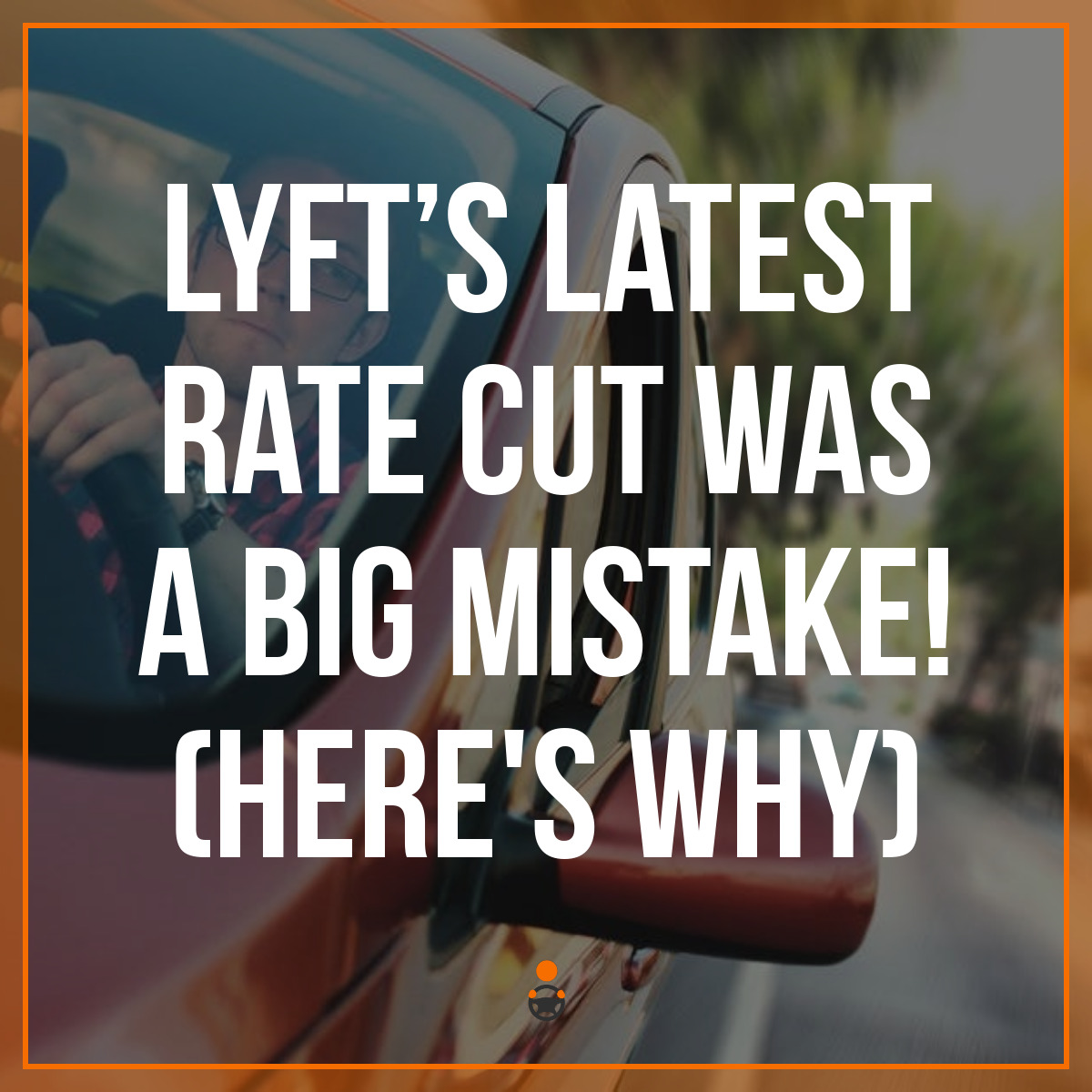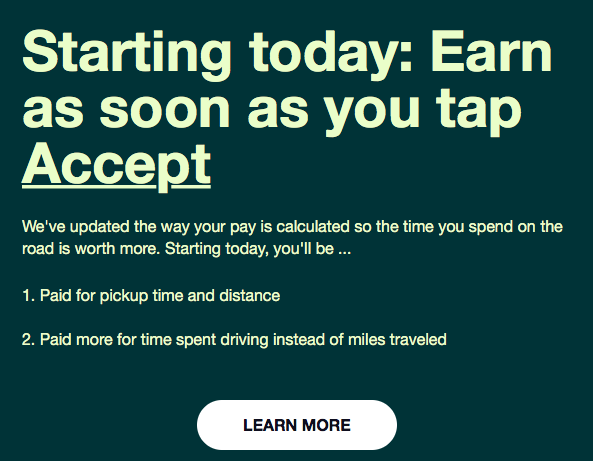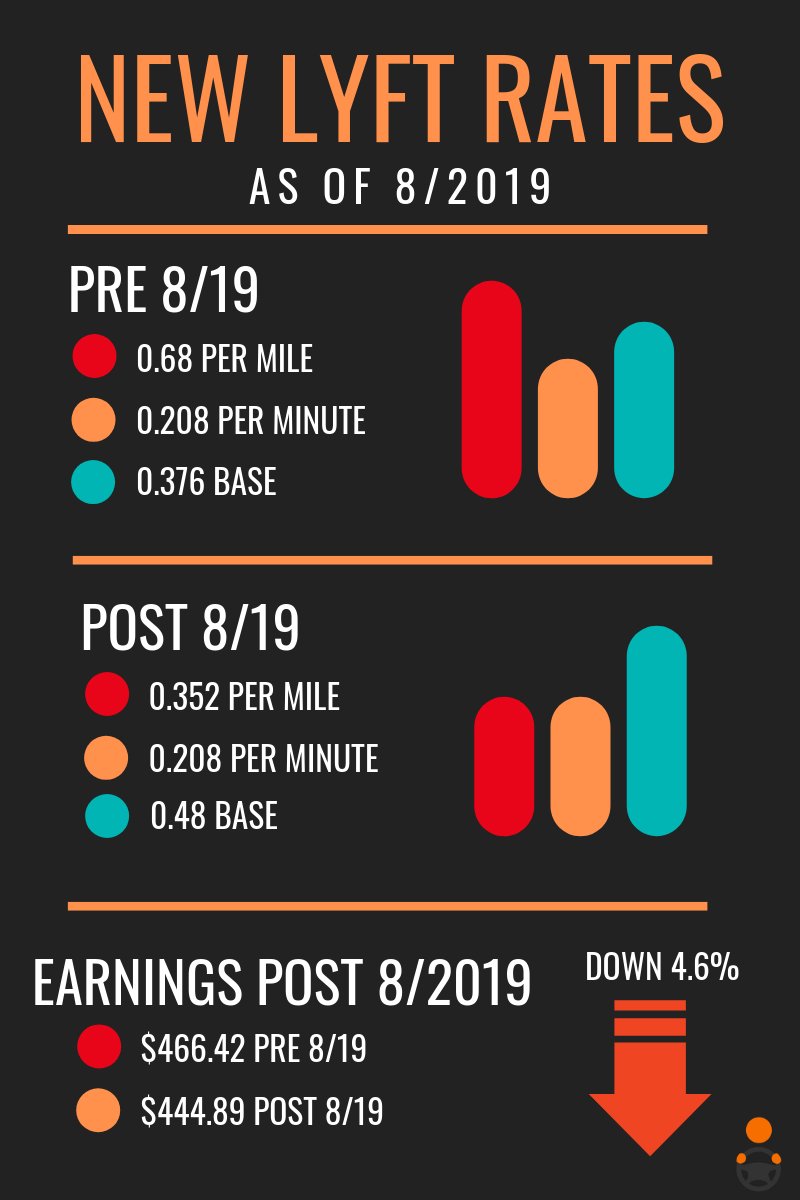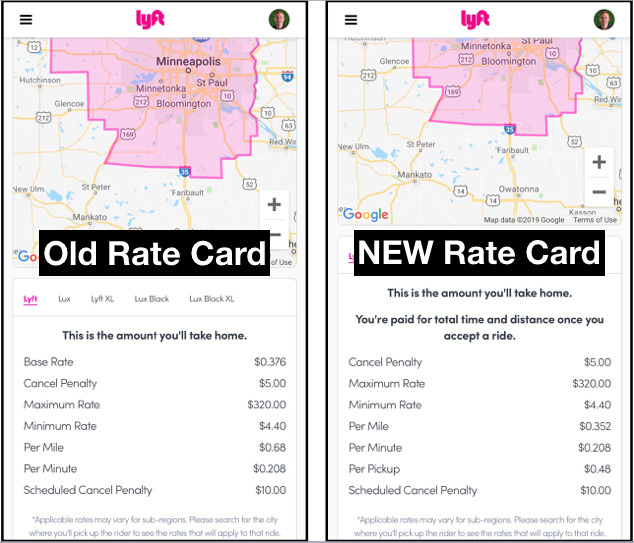Over the past few weeks, Lyft has been rolling their rate cuts out to more markets nationwide. We covered the Lyft rate cuts and other changes Lyft has made to driver pay, and below RSG contributor Joe Pierce covers what the rate cuts have meant for Lyft drivers in his city of Minneapolis.
Lyft cut rates in over a dozen markets recently – the per mile rate here in Minneapolis was cut nearly 50%! Their justification for these rate cuts is we are now being paid for time and distance from the moment we accept a ride.


At first glance this looks like a positive step forward, as we are now getting paid when en route to a passenger, but then you look at the rates and see that the per mile here in Minneapolis was cut by nearly 50% which doesn’t even pass the smell test. Minneapolis was just the most recent city to experience these changes – as of now, 13 cities are currently adjusting to these new rates. You spend more time with a pax than without a pax so a 50% mileage drop mathematically could not make up for getting paid during Period 2.
Lyft’s Changes to Driver Pay Rates
So why did Lyft make this pay change? They are trying to incentivize drivers to accept all rides. Hypothetically, they expect that if I see a ping from 10 miles away, paying me a nearly 50% reduced mileage rate is enough incentive for me to accept that request.
Here is a better idea Lyft: improve your algorithm and make your system more efficient so we don’t get these far away pings in the first place. I can’t tell you how many times I have declined one of these 10+mile away pings and then within the next minute I get a request from within a mile. That is a system problem – don’t incentivize drivers to make your system more inefficient!
Lyft Rate Changes in Action
I decided to give these rates a chance this past week and see how it would go. I tracked my earnings in a spreadsheet with the new rates compared to the old rates. I gave a total of 55 rides with and average pickup of 2 miles and 6 minutes away. For the week my earnings were down 5% total and a whopping 25% on rides longer than 10 miles. Previously these long rides were ideal, but that is no longer the case.
Monday and Tuesday are where I get the bulk of my rides; I drive 11-12 hours each day. On Tuesday I had an average pickup time and distance of 5 minutes and 1.5 miles, ideal under the old rate system. But I also had a lot of long rides on Tuesday, and my earnings that day alone were down 10% – I was pretty pissed.
Oh, and Lyft also still has those 30+ & 45+ minute trip alerts when you are pinged with longer rides. I received both a 30+ & 45+ ping on Tuesday and immediately declined both of them. The pickups for those were awesome too, as both requests came from within a mile away, but I knew I would be losing so much money on the rides that they weren’t worth it.
One semi-positive thing I can point out, and I’m not sure if this is going to be standard or Lyft has yet to catch it, is this week I was paid time and distance from the instant a ride was added to my queue. Basically I was being paid double time and distance while the current ride was still in progress. Honestly it wouldn’t surprise me if this is a mistake that Lyft will correct soon.
How to Make the Lyft Pay Changes Work for Drivers
Come Wednesday, I changed my strategy. Wednesday-Friday I only drive during the morning rush for a few hours, so I decided to only use destination mode. I had one long ride to start the day and then a few short ones, but I lost money on the long rides and made money on the short ones compared to the old rates. I was still down a few dollars in earnings compared to the old rates, not great, but better than Tuesday.
Again, a 5% decrease in overall earnings and a 25% decrease on rides of 10+ miles for the week – not a great experience.
Here’s the deal: Lyft is going to continue to try and make their system more efficient with lower ETAs on pickups by adding more and more drivers. The better the system gets, the less we are paid. The messaging is that we should be happy when the system gets more efficient, we shouldn’t be hoping for longer pickups – but this disconnect isn’t good for drivers.
What should they have done instead? Improve the algorithm, try and predict demand better. I shouldn’t have to decline a ride that is 10+ miles away knowing that I will probably get a nearby ride shortly. This is something the system should know!
Also, do a better job of promoting scheduled rides for requests from the suburbs. Educate suburban users that they have a much better chance of getting a driver on time when they schedule their ride in advance. Lyft should also allow drivers to receive notifications on these scheduled rides when they are added to the system.
Or, and here’s a novel idea, charge passengers more for these far away pings and pay drivers accordingly! If a passenger wants a driver to travel 10+ miles to pick them up, they should have to compensate the driver for all time and distance.

What Can Drivers Do About These Pay Changes?
As far as we can tell, these rate changes are here to stay – so what can drivers do? The main thing would be to switch over to Uber. My assumption is that Uber hasn’t made these rate changes because their system is more efficient, they have more drivers and a better algorithm than Lyft in these markets and don’t need to make the change. But, we all know Uber well enough by now, if this works for Lyft, they may follow suit soon.
For those that continue to drive for Lyft, you are going to want to limit your long rides and focus on medium and shorter ones. Long rides with nearby pickups are worth so much less now. Also, as long as Lyft keeps those long trip alerts in the app, decline those, they just aren’t worth it anymore.
Also, try alternative ways to supplement your rideshare earnings with services like Cargo and Freebird. Make sure you are using an app like GetUpside to save big money on gas. You could easily make 5-10% more using 2-3 of these services and offset a pay cut just like this.
Again, these rate changes were a big mistake, and quite frankly it’s unlike Lyft to take the lead on something like this. Uber has usually been the one to do this type of damage first and Lyft just follows along like a lost puppy. But Lyft is a public company now, so maybe the Uber mentality is beginning to pervade them.
How many of you were affected by these changes and what has it done to your bottom line? Have you decided to quit Lyft cold turkey? Have you come up with any strategies to beat Lyft’s new pay structure? Leave a comment and let us know.
-Joe @ RSG





